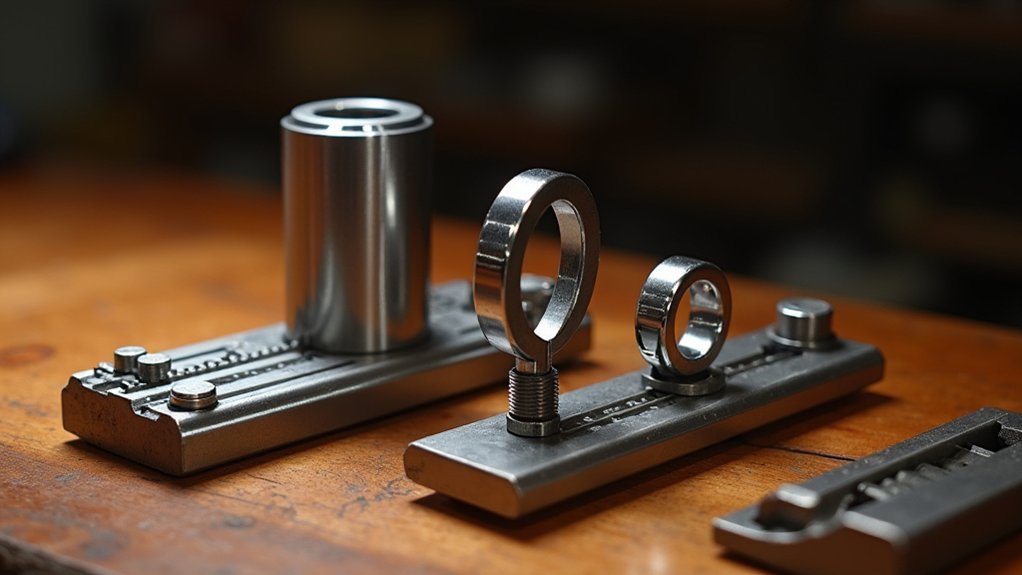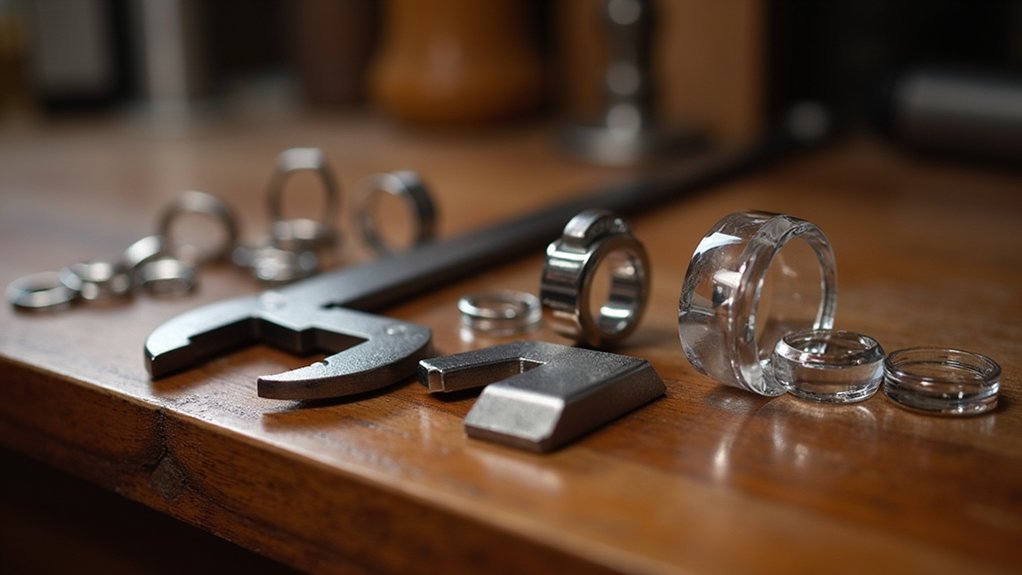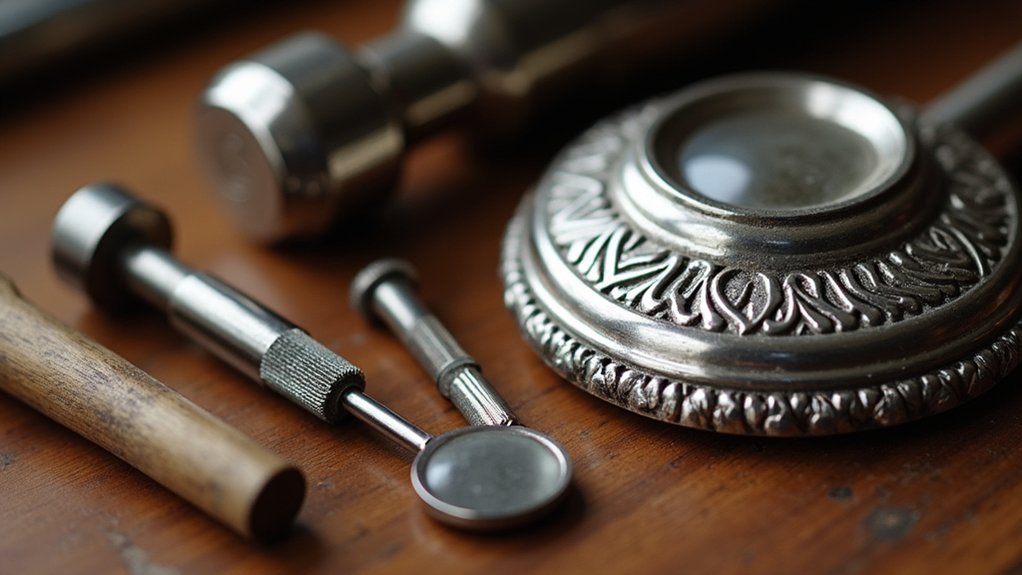You’ll need essential ring gauges like a MULTISIZER for accurate finger measurements, plus a quality ring mandrel with etched quarter sizes for precise shaping. Invest in ring cutting tools—either electric cutters for efficiency or manual pliers for control—alongside stretching and compression equipment for non-destructive resizing. Digital calipers measuring to 0.01 millimeters guarantee fine adjustments, while reliable ring clamps secure jewelry during work. Professional hammers and bench blocks complete your setup for consistent, customer-satisfying results that’ll elevate your entire sizing operation.
Essential Ring Gauges and Sizing Sets

Accuracy forms the foundation of professional ring sizing, and investing in quality gauges and sizing sets guarantees you’ll measure every customer’s finger correctly.
Ring gauges like the MULTISIZER Ring Sizing Gauge (sizes 1 to 17 for $0.73) and Snap-Out Plastic Ring Sizer Gauge (pack of 12 for $6.79) provide essential measurement capabilities for standard rings.
When working with comfort fit designs, you’ll need specialized Comfort Fit Finger Gauges featuring half sizes from 1 to 15 ($22.88).
The True Size Ring Mandrel ($39.95) complements your gauges with etched quarter sizes for precise shaping and resizing work.
Using multiple widths and fits enhances accuracy by accommodating diverse finger shapes.
Purchase gauges and mandrels from the same brand to ascertain compatibility and consistent measurements throughout your sizing process.
Professional Ring Mandrels and Calibration
While gauges provide the initial measurements, professional ring mandrels transform those readings into precise sizing adjustments that meet industry standards. You’ll find that tools like the True Size Ring Mandrel feature etched quarter sizes for enhanced accuracy during your sizing work.
A quality steel ring mandrel typically spans 11.5 inches and covers sizes 1 to 15. The tapering design guarantees you can achieve perfect fits while maintaining wearer comfort. When using your ring mandrel, remember that the leading edge of the shank determines proper sizing, with acceptable tolerance of 1/8 finger size up or down.
| Feature | Specification |
|---|---|
| Length | 11.5 inches |
| Size Range | 1 to 15 |
| Material | Steel construction |
| Tolerance | ±1/8 finger size |
Calibration consistency between your mandrels and gauges prevents sizing inaccuracies.
Ring Cutting and Removal Tools

When you need to remove a stuck or damaged ring, you’ll choose between electric cutters ($149.99) that offer speed and ease, or manual ring cutter pliers ($55.00) that provide precise control during the cutting process.
You must maintain your cutting tools by replacing blades regularly—professional-grade options like Beaver Ring Cutter blades cost $38.90, while economy replacements are available for $8.79.
You can’t overlook safety protocols during ring removal, as proper technique protects both the wearer’s finger and preserves as much of the ring material as possible.
Electric Vs Manual Cutters
As you evaluate ring cutting tools, you’ll find that electric and manual cutters each offer distinct advantages for different situations.
Electric-powered ring cutters deliver exceptional efficiency at around $149.99, making them ideal for professional environments where speed matters. You’ll appreciate their battery operation and quick removal capabilities when handling multiple Ring Sizer adjustments daily.
Manual ring cutter pliers cost approximately $55.00, offering budget-friendly control for precise cutting. You’ll need more physical effort, but they’re perfect for hobbyists or limited budgets.
Professional-grade options like the Beaver Ring Cutter 4100 at $249.95 provide superior durability and precision. Don’t forget replacement blades at $38.90 to maintain cutting effectiveness.
Choose electric cutters for speed and convenience, or manual tools for affordability and hands-on control.
Blade Replacement and Maintenance
Your ring cutting tool’s performance depends heavily on maintaining sharp, effective blades through regular replacement and proper care.
When your blade becomes dull, you’ll notice decreased cutting efficiency and potential safety risks.
The Beaver Ring Cutter 4100 Professional requires a $38.90 replacement blade to maintain its effectiveness, while hardened steel saw blades for models 48.180, 48.183, and 48.195 cost $16.95.
For basic ring cutters, high-quality stainless steel replacement blades are available for just $5.95, offering excellent cutting precision and reduced ring damage risk.
Regular blade replacement isn’t just about performance—it’s about safety too.
Clean your blades after each use and replace them when you notice reduced cutting efficiency to guarantee consistent results in jewelry repair tasks.
Safety During Ring Removal
Since ring removal often involves emergency situations where fingers may be swollen or injured, you’ll need to prioritize safety protocols that protect both yourself and your customer throughout the cutting process.
Ring cutting tools require proper training to guarantee you’re using correct techniques that minimize injury risks. When operating electric-powered cutters or ring cutter pliers, maintain controlled movements to prevent damage to surrounding skin tissue.
Position protective barriers between the cutting blade and the customer’s finger whenever possible. Keep replacement blades sharp and properly maintained, as dull blades require excessive force and increase accident potential.
Always explain the procedure to your customer beforehand to reduce anxiety and unexpected movements.
Professional-grade tools like the Beaver Ring Cutter 4100 offer enhanced precision and safety features that make emergency removals more manageable and secure.
Ring Stretching and Compression Equipment

You’ll find ring stretching and compression equipment crucial for resizing soft metals like gold and silver without cutting.
These tools include various ring stretcher types and compression mandrel systems that can increase ring sizes by up to one full size.
Understanding metal compatibility guidelines guarantees you’ll choose the right equipment for each specific ring material and avoid damaging delicate designs.
Ring Stretcher Tool Types
Two primary categories of ring sizing equipment dominate the jewelry maker’s toolkit: stretching tools that expand rings and compression tools that reduce their size.
You’ll find that ring stretchers work best with soft metals like gold and silver, allowing precise adjustments without damaging the ring’s integrity. A Ring Stretcher Tool Kit typically includes a tapered mandrel and expander rod for efficient sizing operations.
When you’re working with compression tools, they’ll reduce ring sizes by applying even pressure while maintaining the shank’s shape.
You should exercise caution with rings containing stones or delicate designs, as the stretching process can potentially damage these features.
- Use ring stretchers for sizes 6-10 with one-size maximum increase
- Apply light hammer taps when expanding rings on mandrels
- Choose compression tools for reducing ring sizes safely
- Avoid sizing rings with fragile stones or intricate details
Compression Mandrel Systems
Three essential components make compression mandrel systems the cornerstone of professional ring resizing: the tapered mandrel, adjustable compression mechanism, and calibrated sizing markers. You’ll find these tools accommodate various ring widths while maintaining precision throughout the resizing process. Unlike traditional stretching methods, your compression mandrel system minimizes damage to delicate designs and embedded stones.
| Feature | Benefit |
|---|---|
| Tapered Design | Accommodates multiple ring sizes |
| Incremental Adjustments | Achieves 1/8 size tolerance |
| Compression Mechanism | Reduces metal stress |
| Calibrated Markers | Guarantees accurate sizing |
| Stone-Safe Operation | Protects delicate elements |
Your Ring Sizing System’s well-calibrated compression mandrel dramatically improves bench work efficiency. You’ll achieve consistent, accurate results that enhance customer satisfaction with ring fittings, making this investment essential for professional jewelers seeking precision and reliability.
Metal Compatibility Guidelines
While compression mandrel systems excel with precious metals, understanding material compatibility prevents costly mistakes and equipment damage.
You’ll achieve superior results when working with soft metals like silver, gold, and copper. These materials respond predictably to stretching forces without cracking or breaking.
However, you should avoid using ring stretching tools on harder metals such as titanium, tungsten, or stainless steel. These materials resist deformation and can damage your equipment or create safety hazards.
- Limit stretching to rings between Ring Size 6-10 for best results
- Increase maximum one full size to prevent metal fatigue
- Apply lubricants like WD-40 for easier mandrel removal
- Avoid stretching rings with delicate designs or set stones
Consider alternative methods like C-clamps for better control during delicate operations.
Precision Measuring Instruments and Calipers

Accuracy forms the foundation of professional ring sizing, and precision measuring instruments like digital calipers deliver the exact measurements you need for perfect fits.
Digital calipers stand out as the preferred choice, measuring down to 0.01 millimeters for fine adjustments that guarantee customer satisfaction.
You’ll also need wire gauge tools and rulers to determine metal, jump ring, and wire sizes accurately.
These measurements directly impact your final product’s quality, so investing in high-quality, calibrated instruments reduces sizing errors considerably.
Consistent use of proper measuring tools enhances your ability to meet customer expectations while reducing post-fitting resizing needs.
When you prioritize precision measuring instruments in your bench work, you’re building a foundation for reliable, professional ring sizing that keeps customers returning.
Bench Block and Hammering Tools
Foundation work in ring sizing demands reliable hammering tools paired with a sturdy bench block to achieve professional results. Your hardened steel bench block provides the essential foundation for metal stamping and shaping operations.
A reliable bench block and quality hammering tools form the essential foundation for achieving professional-grade ring sizing results.
You’ll need various jewelry hammers in your toolkit, including brass and hardened tool steel versions designed for specific tasks like flattening and texturing metals.
- Planishing hammers smooth out imperfections and create even surfaces on ring bands
- Brass hammers prevent marring while work hardening precious metals during sizing
- Plastic mallets offer delicate adjustments without damaging soft metals or gemstone settings
- Riveting hammers secure joints and set hardware components with precision control
These hammering tools enhance your precision and quality, ensuring better results in ring sizing projects when combined with proper bench block techniques.
Specialized Pliers for Ring Work

The right specialized pliers transform intricate ring work from frustrating struggles into precise, controlled operations.
You’ll need chain nose pliers as your go-to tool for opening and closing jump rings while handling wire wrapping and crimping tasks. Their tapered design gives you exceptional control when shaping and bending wire during ring assembly.
Jewelry cutter pliers are equally essential, delivering clean cuts in both round and flat wire without leaving burrs that compromise your professional finish.
You should invest in flat nose and round nose pliers too, as they’ll enhance your design flexibility and construction capabilities.
When selecting specialized pliers, prioritize comfortable grips and durable materials that’ll withstand frequent use during ring sizing and adjustments.
Ring Clamps and Holding Fixtures
You’ll need reliable ring clamps and holding fixtures to maintain precise control during sizing operations.
These tools feature various clamping mechanisms that secure rings in ideal positions while you work, preventing slips that could damage the piece or cause injury.
Different bench fixture types accommodate everything from simple bands to complex settings, ensuring you can position any ring securely for accurate measurements and modifications.
Ring Clamping Mechanisms
When working with delicate rings during resizing or shaping, you’ll need reliable clamping mechanisms to secure your pieces while maintaining complete control over your tools.
A quality Ring Clamp provides the essential support you require for precision bench work, preventing damage while ensuring accurate modifications.
Wood ring clamps offer excellent grip without scratching precious metals, while adjustable jewelry clamps accommodate various ring sizes and shapes.
Ring stands with ceramic mandrels combine secure holding power with heat resistance for soldering operations.
- Safety Enhancement – Reduces slip risks and accidents during detailed work
- Improved Precision – Maintains steady positioning for accurate modifications
- Tool Protection – Preserves integrity of both rings and working instruments
- Versatile Accommodation – Adjustable designs fit different ring dimensions effectively
Bench Fixture Types
Building on these foundational clamping principles, several distinct bench fixture types offer specialized advantages for different ring sizing applications. You’ll find adjustable ring clamps accommodate various sizes and shapes effectively, while fixed models provide maximum stability for consistent work. Padded surfaces protect your rings from scratches during the sizing process.
| Fixture Type | Primary Advantage |
|---|---|
| Adjustable Clamps | Versatility across ring sizes |
| Fixed Position Clamps | Maximum stability and precision |
| Padded Ring Holders | Scratch protection |
| Multi-Angle Fixtures | Access from different positions |
| Spring-Loaded Clamps | Quick setup and release |
Investing in high-quality fixtures greatly enhances your bench work efficiency and accuracy. These tools prevent movement and slippage, ensuring you’ll achieve consistent results while reducing errors in your ring sizing projects.
Secure Ring Positioning
Since proper ring positioning forms the foundation of successful ring sizing, mastering the use of ring clamps and holding fixtures becomes your next critical skill.
These essential tools provide the secure grip you need while working on delicate pieces. Ring clamps offer various designs specifically engineered for different tasks, whether you’re soldering, resizing, or performing intricate detail work.
- Wood ring clamps deliver lightweight yet sturdy support for steady hands-free operation
- Specialized holding fixtures reduce slipping risks and prevent accidental drops during bench work
- Enhanced stability allows you to focus entirely on precision tasks without worrying about ring movement
- Secure ring positioning enables accurate work while protecting the ring’s structural integrity throughout the sizing process
Replacement Parts and Maintenance Supplies
Although ring sizing tools are built to last, they’ll inevitably require replacement parts and regular maintenance to perform at their finest.
You’ll want to stock essential replacement parts like the Replacement Blade for Beaver Ring Cutter 4100 ($38.90) for continued precision during ring resizing tasks.
Don’t overlook smaller components such as the Replacement Locking Nut Key for Ring Cutter Pliers ($8.85), which keeps your tools functioning effectively.
Quality replacement blades, including the Economy Ring Cutting Pliers blade ($8.79), enhance cutting efficiency while reducing damage risks.
Consider maintaining a selection of hardened steel saw blades ($16.95) for various ring cutter models.
This proactive approach lets you quickly address tool wear, maintain productivity, and guarantee accuracy that ultimately improves customer satisfaction.
Environmental Considerations for Accurate Sizing
When you’re measuring rings for proper sizing, environmental factors greatly impact accuracy and can mean the difference between a perfect fit and an uncomfortable customer experience.
Temperature fluctuations cause finger dimensions to vary throughout the day, making consistent measurement conditions essential for reliable results. You’ll notice customers’ fingers swell in the evening due to fluid accumulation, so timing your ring sizing sessions matters considerably.
- Schedule sizing appointments during mid-morning hours when finger size is most stable
- Maintain your workshop temperature between 68-72°F for consistent measurement conditions
- Account for seasonal variations by remeasuring returning customers after several months
- Consider humidity levels, as higher moisture can cause fingers to swell and affect ring fit
Geographic differences in average finger dimensions also influence your local sizing practices.
Customer Finger Assessment Techniques
Temperature and timing provide the foundation for accurate measurements, but your success depends on properly evaluating each customer’s unique finger characteristics.
You’ll need to assess knuckle size, finger shape, and any existing swelling before selecting appropriate sizing tools. Use calibrated finger gauges or mandrels to accommodate these individual variations and guarantee precise measurements.
During the fitting process, prioritize customer comfort by checking that the ring feels snug without being overly tight.
Remember that a tolerance of 1/8 finger size is acceptable for future adjustments. Don’t forget to take into account seasonal changes and humidity levels, as these environmental factors cause finger size fluctuations.
Your thorough assessment techniques will determine whether the final ring fit meets your customer’s long-term comfort expectations.
Frequently Asked Questions
What Tools Does a Bench Jeweler Need?
You’ll need basic hand tools like pliers, files, and saws for cutting and shaping. Add measuring instruments, torches for soldering, hammers for texturing, and specialized tools like ring mandrels for forming jewelry pieces.
What Tools Are Needed to Resize a Ring?
You’ll need ring gauges, a calibrated mandrel, ring cutter, plastic mallet, jewelry hammer, and ring stretcher. Don’t forget digital calipers for precise measurements before and after resizing to guarantee you achieve the perfect fit.
What Is the Best Way to Measure Your Ring Size?
You’ll get the most accurate measurement using ring gauges or a ring sizer. Measure at day’s end when your finger’s largest, avoiding cold or hot conditions that affect finger size.
What Can I Use if I Don’t Have a Ring Sizer?
You can wrap a strip of paper around your finger, mark where it overlaps, then measure that length with a ruler. Wire or string works similarly for determining your approximate ring size.
In Summary
You’ve now got a thorough understanding of the ring sizing tools that’ll make your bench work more efficient and accurate. From basic gauges to precision calipers, each tool serves a specific purpose in delivering professional results. Remember that investing in quality equipment and maintaining proper calibration standards will directly impact your work’s accuracy. Master these tools and techniques, and you’ll handle any ring sizing challenge with confidence and precision.





Leave a Reply